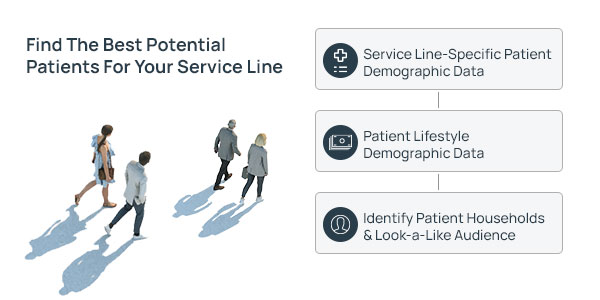Organizing a health system’s patient care by service line is a common operational strategy. But the best service line structure in the world is pointless if the service lines you offer do not match the demand level of each ambulatory facility’s trade area.
Service line optimization efforts aim to maximize investments by ensuring that human and capital resources are deployed to the correct facilities. Whether you are trying to reduce the risk of a bad investment or to identify new offerings, follow these four steps for developing a sustainable service line strategy.
1. Identify Your Patients by Service Line
In light of today’s competitive and rapidly shifting healthcare landscape, it’s critical for health systems to make service line strategy decisions based on the most important driver of success: the patient. However, few systems truly understand who their overall patients are – much less at the service line level.
Combining service line-specific patient demographic data with psychographic data on lifestyles gives healthcare providers a much more complete view of who their patients are and how those patients view healthcare services. Once the patient profile has been defined, it’s possible to identify the other households in your service area that share those same attributes. These households represent your best potential patients for that service line.
2. Understand What Factors Drive a Service Line’s Success
While patients are a critical driver of a service line’s success, there are other variables that influence performance. Demand for medical services and the existing supply of providers are just two of the factors that should be considered when evaluating your strategy for optimal service line placement. These factors can be studied and combined in a service line model that provides insights into expected performance levels.
3. Evaluate Current Facilities to Optimize Your Service Line Strategy
Applying service line models to your existing ambulatory facilities can reveal opportunities to add service lines at facilities that do not already offer them. Reduce waste and maximize your limited capital and staffing resources by placing service lines at facilities with the highest opportunity for success.
4. Design Marketing Messages for Each Service Line
After optimizing your service line placement, maximize your return on investment through marketing campaigns that cater to the core consumer group for each service line. Understanding the media channels patients respond to by service line and taking a highly targeted approach can help your system to drive patient acquisition more efficiently.
The Bottom Line: Use Service Line Optimization to Guide Investments
Studying the factors that drive your system’s service line performance allows you to make informed decisions about capital deployment. Grow top-line revenue and reduce waste by identifying opportunities to add new service lines at existing facilities and developing targeted marketing campaigns for specific service lines. When executed correctly, service line optimization exercises can truly drive sustainability.
You've learned about service line optimization, now dig in deeper and learn more about how marketing can help you maximize your ROI: "Beyond National Segments: A Look at Marketing Segmentation in Healthcare Today."



